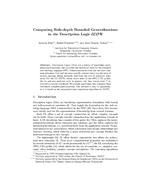Computing Role-depth Bounded Generalizations in the Description Logic ELOR
From International Center for Computational Logic
Computing Role-depth Bounded Generalizations in the Description Logic ELOR
Andreas EckeAndreas Ecke, Rafael PeñalozaRafael Peñaloza, Anni-Yasmin TurhanAnni-Yasmin Turhan
Andreas Ecke, Rafael Peñaloza, Anni-Yasmin Turhan
Computing Role-depth Bounded Generalizations in the Description Logic ELOR
In Ingo J. Timm and Matthias Thimm, eds., Proceedings of the 36th German Conference on Artificial Intelligence (KI 2013), volume 8077 of Lecture Notes in Artificial Intelligence, 49-60, 2013. Springer
Computing Role-depth Bounded Generalizations in the Description Logic ELOR
In Ingo J. Timm and Matthias Thimm, eds., Proceedings of the 36th German Conference on Artificial Intelligence (KI 2013), volume 8077 of Lecture Notes in Artificial Intelligence, 49-60, 2013. Springer
- KurzfassungAbstract
Description Logics (DLs) are a family of knowledge representation formalisms, that provides the theoretical basis for the standard web ontology language OWL. Generalization services like the least common subsumer (lcs) and the most specific concept (msc) are the basis of several ontology design methods, and form the core of similarity measures. For the DL ELOR, which covers most of the OWL 2 EL profile, the lcs and msc need not exist in general, but they always exist if restricted to a given role-depth. We present algorithms that compute these role-depth bounded generalizations. Our method is easy to implement, as it is based on the polynomial-time completion algorithm for ELOR.
There is also an extended technical report.
- Forschungsgruppe:Research Group: AutomatentheorieAutomata Theory
@inproceedings{ EcPeTu-KI-13,
address = {Koblenz, Germany},
author = {Andreas {Ecke} and Rafael {Pe{\~n}aloza} and Anni-Yasmin {Turhan}},
booktitle = {Proceedings of the 36th German Conference on Artificial Intelligence (KI 2013)},
editor = {Ingo J. {Timm} and Matthias {Thimm}},
pages = {49--60},
publisher = {Springer-Verlag},
series = {Lecture Notes in Artificial Intelligence},
title = {Computing Role-depth Bounded Generalizations in the Description Logic {$\mathcal{ELOR}$}},
volume = {8077},
year = {2013},
}
